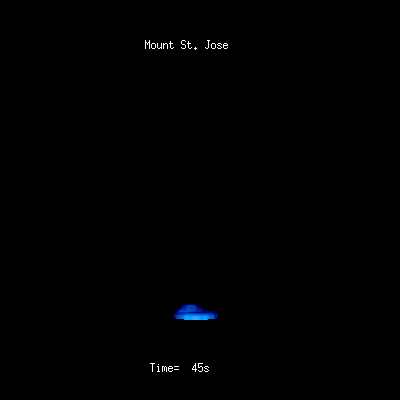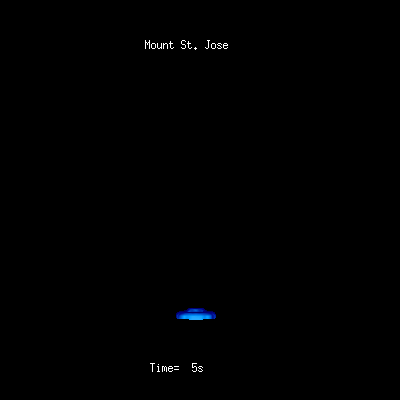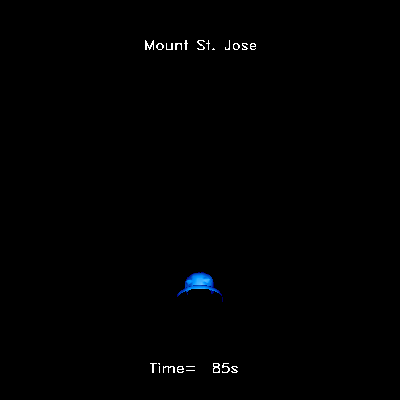| Michigan Tech Home | Department of Geological Engineering & Sciences | Remote Sensing Institute | MTU Volcanoes Page | Volcanic Clouds Web Site | Total Ozone Mapping Spectrometer (TOMS) | Volcanic Ash Advisory Centers (VAAC) | Smithsonian Institution | Alaska Volcano Observatory |
Main Topics
Subtopics
Overview: Science Issues
What Are Volcanic Clouds?
Excerpted from W I Rose et al, 2000, Philos Trans Royal Society London, 358: 1433-1729
Clouds
Clouds are suspensions of particles in the atmosphere. Meteorological clouds contain particles that are mainly liquid or solid H20 (hydrometeors) which are smaller than about 100 microns in diameter and which fall through the atmosphere in a laminar regime at velocities of less than about 0.1 m/sec. Larger meteorological particles fall much faster, in the turbulent regime, and are called precipitation (Rogers and Yau, 1989; Houze, 1993). Because of the slow fall speeds of their particles, clouds can persist in the atmosphere for periods of hours to weeks or longer, although they often are dynamic.
Volcanic Clouds
Volcanic clouds are much rarer features than meteorological clouds. They are initiated by explosive eruptions which release volcanic gases and hot silicate fragments called pyroclasts and form vertical buoyant columns or plumes which rise to heights of up to 50 km as heat is transferred from the hot pyroclasts to entrained air from the surrounding atmosphere (Sparks et al, 1997; Gilbert and Sparks, 1998). Large amounts of lower tropospheric air are entrained in these plumes (Woods, 1993; Glaze and Baloga, 1996; Glaze et al, 1997), and this air typically contains water vapor which saturates the rising air as it rises and condenses, forming hydrometeors. Large pyroclasts fall out of the eruption column margins quickly (Ernst et al, 1996)--lapilli (pyroclasts >2 mm in diameter) fall back to earth within less than about 30 minutes (Walker et al, 1971; Wilson and Huang, 1979; Lane et al, 1993). Ash (pyroclasts < 2 mm in diameter) particles fall out more slowly and fine ash (<50 microns in diameter) falls out in the laminar flow regime (Rose, 1993; Bonadonna et al, 1998) at slow velocities like the particles in meteorological clouds. So, like meteorological clouds, volcanic clouds can persist in the atmosphere for days to weeks or longer. Typically they detach from plumes before or after the eruption stops and drift in response to the 3 dimensional wind patterns (Servranckx, et al, 1996).
3-D Numerical Models of Volcanic Plumes
Reference: website, Jose A. Vergara and Ferdinand BAER (University of Maryland).
A three-dimensional numerical model was employed to simulate the behavior of the volcanic plumes. The gas phase includes water vapor and atmospheric air. The partial differential equations of conservation of mass, momentum, and energy were solved numerically, by a finite semi-implicit difference scheme, on an asymmetric physical domain for different temperature and wind atmospheric vertical profile. For each case, three dimensional numerical simulations of the plume were run on a workstation. The results show the formation of a convective and umbrella cloud similar to field observations. The height of the umbrella was a strong function of the discharge and atmospheric vertical profile. As an example, for Pinatubo-like simulation the spread of the cloud umbrella was locates at about 20 km, the column height was 37 km and the maximum ascent velocity of volcanic columns was 262 m/s. The volcano clouds reach the stratosphere in just 10 minutes. The results from simulations appear to be qualitatively in agreement with the field observations and conceptual models.
What is in volcanic clouds?
Volcanic clouds contain a variety of components including
1. volcanogenic products from the eruption: volcanic gases, pyroclasts, and aerosol particles derived from reactions of volcanogenic and atmospheric materials; and
2. products from the ambient atmosphere, such as H20 and gaseous species and various particles from the land and sea including wind blown silicates, sea salt and others. The volcanogenic components make the clouds distinctive, and they can be tracked by satellite sensors for periods that range from minutes to weeks (Bluth et al, 1997; Schneider et al, 1995). During this time the volcanogenic particles mix and interact with meteorological and hydrospheric particles.
Volcanogenic particles in volcanic clouds consist of fine pyroclasts, salts and acids in aerosol form. Direct sampling of volcanogenic particles has been accomplished by balloon studies (e.g. Rietmeijer, 1993) and a variety of research aircraft. Volcanogenic particles in volcanic clouds have been examined in a number of studies (Table 1 lists only a few of these) where a research aircraft with a particle collection system was flown through the clouds.
Table 1: Direct sampling studies of small particles in volcanic clouds.
Volcano
Date (s)
Cloud description
Reference
Fuego, Guatemala
1978, 80
small basaltic ash clouds
Cadle et al, 1979; Lazrus et al, 1979; Rose et al, 1980
Santiaguito, Guatemala
1978, 80
small dacitic ash clouds
Cadle et al, 1979; Lazrus et al, 1979; Rose et al, 1980
Pacaya, Guatemala
1978, 80
gas emission plume
Cadle et al, 1979; Lazrus et al, 1979; Rose et al, 1980
Mt St Helens, USA
1980, 81
small ash clouds, gas plumes
Rose et al, 1982
Poas, Costa Rica
1982
plume through crater lake
Casadevall et al, 1984
Arenal, Costa Rica
1982
gas emission plume
Casadevall et al, 1984
Colima, Mexico
1982
gas emission plume
Casadevall et al, 1984
El Chichón, Mexico
1982
stratospheric halite and sulfate
Woods et al, 1985
Erebus, Antarctica
1985
gas emission plume
Chuan et al, 1986
White Island, N.Z.
1985
gas emission plume
Rose et al, 1986
Augustine, Alaska
1986
small andesitic ash clouds
Rose et al, 1988
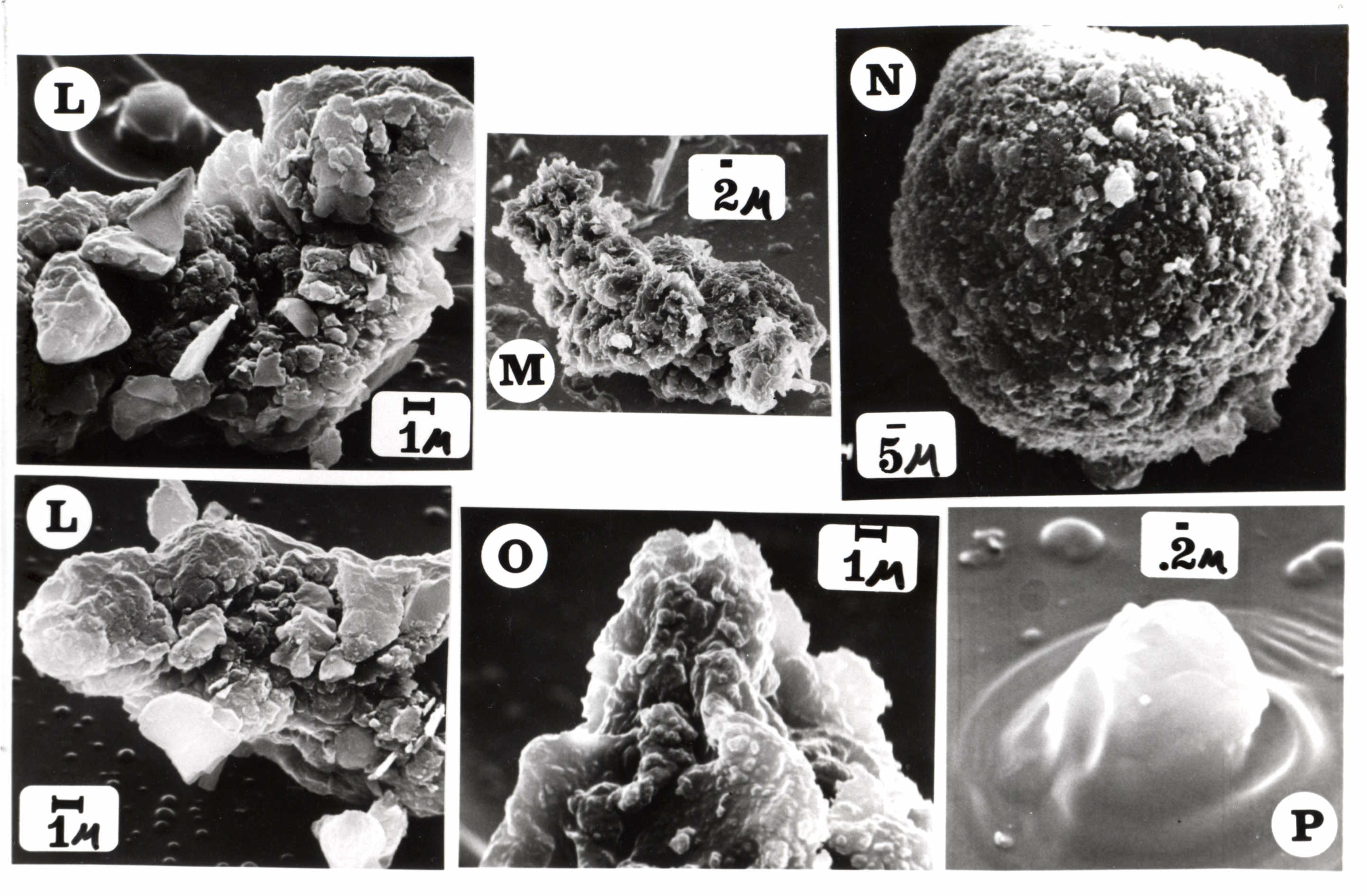
Because
of safety, only plumes and relatively small volcanic clouds have
been directly sampled in this way. The particles consist of two
main types:
Silicate pyroclasts
Silicate pyroclasts represent fragments of the magma. These are glassy pyroclasts and minerals, which represent the crystalline fraction of the magma. Their shape is angular, and basaltic and andesitic eruptions give rise to particles that have moderate aspect ratios (Riley et al, 1999), while rhyolitic eruptions can generate an abundance of glassy pyroclasts with a platy geometry and extreme aspect ratios (Rose and Chesner, 1987). The diameters of silicate pyroclasts generated during explosive eruptions range from meters to microns. Those in volcanic clouds are smaller, generally less than about 50 microns. The mass proportions of silicate particles with diameters less than about 1 micron are very small (Rose et al 1980).
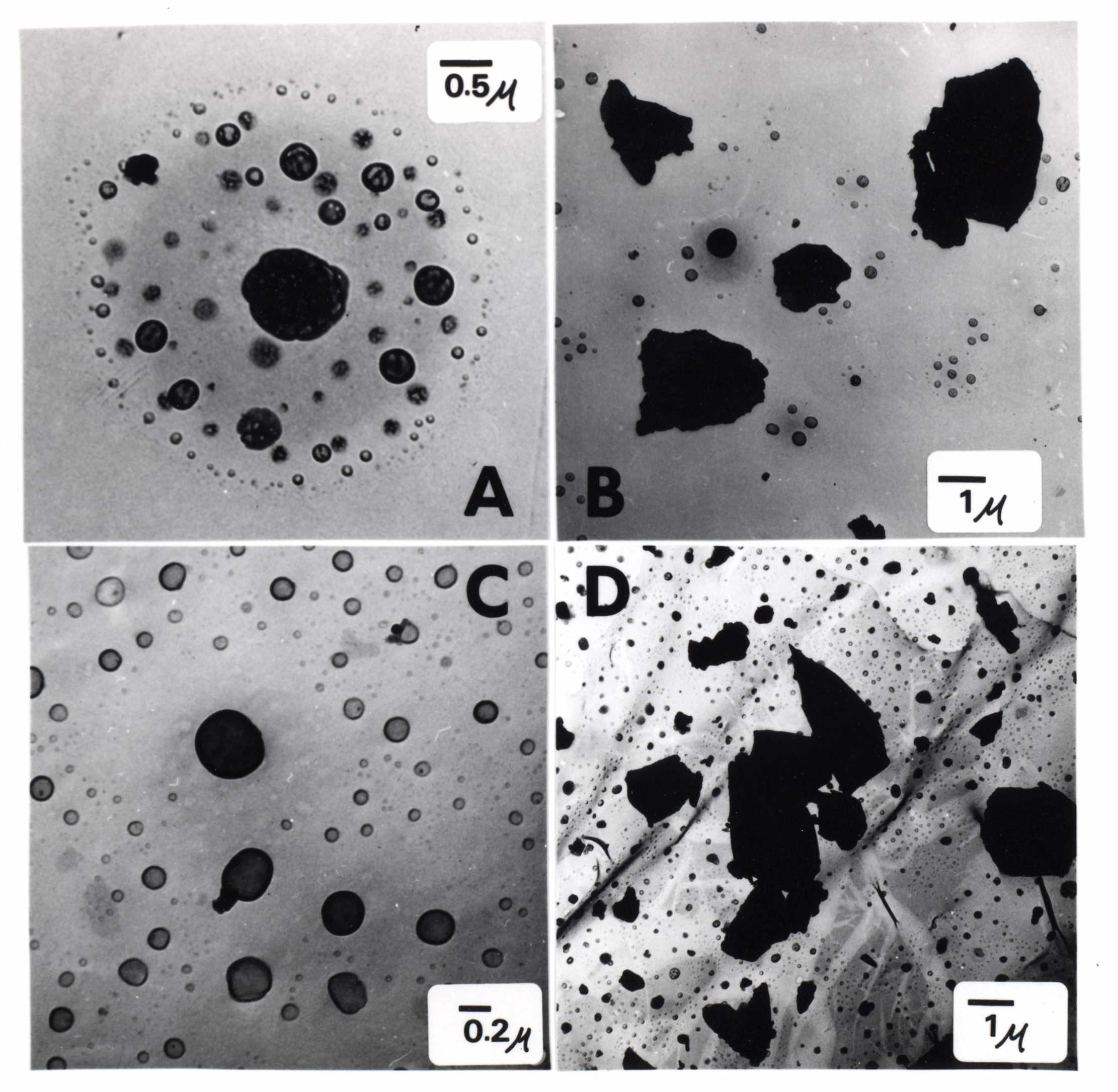
Non-silicate
particles
Non-silicate particles are related to reactions among the constituents of the volcanic gases. These particles are generally smaller than the silicates, usually less than 1 micron in diameter. The most common composition for these is sulfate, especially H2SO4, which forms as submicron spherical droplets which also contain H20 (typically about 25% by volume--Zhao et al, 1995). A total of at least 28 different phases have been observed also (see Table 3 in Rose et al, 1982 for a partial list) including native sulfur, sulfates, haloids, metallic oxides, and such exotic species as silver sulfide and even native gold (Meeker et al, 1985). Overall the analogy between the observed phases and fumarolic incrustations and sublimates at gas vents (Stoiber and Rose, 1974; Bernard, 1985; Symonds et al, 1987) suggests that these phases originate from reactions among the volcanic gases, sometimes involving the atmosphere and volcanic silicates.
Other particles
Besides these two broad types, a wide variety of other, unexplained materials have been observed in volcanic clouds. They consist largely of phases that are amorphous and have uncertain compositions (Chuan et al, 1987). Many or most of these particles are likely to be non-volcanic in origin, and represent accidental material of surficial or extraterrestrial origin.
Gases
Direct sampling and analysis of gases in volcanic clouds has been done only rarely (e.g. Cadle et al, 1979) although analysis of CO2 has been done much more extensively during CO2 flux determination surveys (Harris et al, 1981; Gerlach et al 1999). Other information about gases has been collected from extensive airborne remote sensing of volcanic plumes using the correlation spectrometer (COSPEC) instrument. These results show that the volcanic gases in volcanic clouds are mixed and highly diluted by the ambient atmosphere, and the concentrations of volcanic SO2 and CO2 are less than a few ppmv (McGee, 1992).
References
Bernard A. 1985 Les mecanismes des condesation des gaz volcaniques, Ph D Thesis, Univ Bruxelles, Belgium
Bluth, G. J. S., W. I. Rose, I. E. Sprod and A. J. Krueger 1997 Stratospheric loading from explosive volcanic eruptions, J. Geol., 105, 671-683.
Bonadonna, C, G G J Ernst and R S J Sparks 1998 Thickness variations and volume estimates of tephra fall deposits: the importance of particle Reynolds number, Jour Volc Geoth Res, 81, 173-184.
Cadle, R.D., A.L. Lazrus, B.J. Huebert, L.E. Heidt, W.I. Rose, D.C. Woods, R.L. Chuan, R.E. Stoiber, D.B. Smith and R.A. Zielinski 1979 Atmospheric implications of studies of Central American volcanic eruption clouds, J. Geophys. Res., 84, 6961-6968.
Casadevall, T., W.I. Rose, W. Fuller, W. Hunt, M. Hart, J. Moyers, D. Woods, R. Chuan and J. Friend 1984 Sulfur dioxide and particles in volcanic plumes from Poás, Arenal and Colima Volcanoes, Costa Rica and Mexico: February 1982, J. Geophys. Res., 89, 9633-9641.
Chuan, R.L., J. Palais, W.I. Rose, and P.R. Kyle 1986 Particle sizes and fluxes of the Mt. Erebus volcanic plume, J. Atmos. Chem. 4, 467-477.
Chuan RL, WI Rose and DC Woods 1987 SEM Characterization of small particles in eruption clouds, In Clastic Particles ,ed by J Marshall, pp 159-173.
Ernst, GGJ, MI Bursik, SN Carey and RSJ Sparks 1996 Sedimentation from turbulent jets and plumes, J Geophys Res 101, 5575-5589.
Gerlach T M, M P, Doukas , K A McKee and R Kessler 1999 Airborne detection of diffuse carbon dioxide at Mammoth Montain, Geophys. Res Lett, 26, 3661-3664.
Gilbert J and RSJ Sparks, eds 1998 The physics of explosive volcanic eruptions, Geol Soc London Spec Publ 145, 186pp
Glaze, L S, S M Baloga 1996 Sensitivity of bouyant plume heights to ambient atmospheric conditions: Implications for volcanic eruption columns, J Geophys Res 101, 1529-1540.
Glaze, L S, S M Baloga and L Wilson 1997 Transport of atmospheric water vapor by volcanic eruption columns, J Geophys Res 102, 6099-6108.
Harris, D.M., W.I. Rose, R. Roe and M.R. Thompson 1981 Radar observations of ash eruptions at Mount St. Helens Volcano, Washington, U.S. Geol. Surv. Bull. 1250, 323-334.
Houze, RA , 1993, Cloud Dynamics, Academic Press, New York 573pp.
Lane SJ, Gilbert JS 1992 Electric potential gradient changes during explosive activity at Sakurajima volcano, Japan. Bull Volcanol 54, 590-594.
Lazrus, A.L., R.D. Cadle, B.W. Gandrud, J.P. Greenberg, B.J. Huebert and W.I. Rose 1979 Trace chemistry of the stratosphere and of volcanic eruption plumes, J. Geophys. Res., 84, 7869-7875.
McGee, K. 1992 The structure,dynamics and chemical composition ofnon-eruptive plumes of Mount St Helens, J Volcanol Geoth Res , 51, 269-282.
Meeker, K., Chuan, R., Kyle P.R., Palais, J. 1991 Emission of elemental gold particles from Mount Erebus, Ross Island, Antarctica. Geophys. Res. Lett., 18, 1405-1408.
Rietmaijer, FJM. Volcanic dust in the stratosphere between 34 and 36 km altitude during May, 1985," J Volc Geoth Res, 55, 69-83, 1993.
Riley, CM, GJS Bluth and WI Rose 1999 Characterizing the shapes of pyroclasts in distal fallout material to improve our understanding of fallout rates and transport, IUGG XXII Gen Assembly Proceedings, B 169.
Rogers R R and M K Yau 1989 A Short Course in Cloud Physics, Pergamon Press, 290pp.
Rose, W.I., R.L. Chuan, R.D. Cadle and D.C. Woods 1980 Small particles in volcanic eruption clouds, Am. J. Sci., 280, 671-696.
Rose, W.I., R.L. Chuan and D.C. Woods 1982 Small particles in plumes of Mount St. Helens, J. Geophys. Res., 87, 4956-4962.
Rose, W. I., R. L. Chuan, W. F. Giggenbach, P. R. Kyle and R. B. Symonds 1986 Rate of sulfur dioxide and particle emission from White Island Volcano, New Zealand and an estimate of the total flux of major gaseous species Bulletin of Volcanology, 48, 181 -187.
Rose, W. I., G. Heiken, K. Wohletz, D. Eppler, S. Barr, T. Miller, R. L. Chuan and R. B. Symonds 1988 Direct rate measurements of Mt. St. Augustine Eruption plumes: a problem of scaling up and uncontrolled variables, J. Geophys. Res., 93, 4485-4499.
Rose, W. I., and C. A. Chesner 1987 Dispersal of ash in the great Toba eruption, 75,000 years B. P.,Geology, 15, 913-917.
Rose, W. I. 1993 Comment on "Another look at the calculation of fallout tephra volumes" by Judy Fierstein and Manuel Nathanson, Bull Volcanol. 55, 373-374.
Schneider, D. J., W. I. Rose and L. Kelley 1995 Tracking of 1992 eruption clouds from Crater Peak/Spurr Volcano using AVHRR, U. S. Geol. Surv. Bull. 2139 (Spurr Eruption, edited by T. Keith), 27-36.
Servranckx, René, Réal D'Amours, Michel Jean, Joseph-Pierre Toviessi and Serge Trudel 1996 Volcanic Ash Forecasting at the Canadian Meteorological Centre, Proceedings Pan Pacific Hazards Conference, Vancouver, BC.
Sparks RSJ M I Bursik, S N Carey, J S Gilbert, L S Glaze, H Siggurdsson and A W Woods 1997 Volcanic Plumes, John Wiley and Sons, New York, 574pp.
Stoiber, RE and W I Rose 1974 Fumarolic Incrustations at active Central American Fumaroles, Geoch Cosmoch Acta 38, 495-516.
Symonds, R. B., W. I. Rose, M. H. Reed, F. E. Lichte and D. L. Finnegan 1987 Volatilization, transport and sublimation of metallic and non-metallic elements in high temperature gases at Merapi Volcano, Indonesia , Geoch. Cosmoch. Acta, 51, 2083-2101.
Walker GPL, L Wilson and ELG Bowell 1971 Explosive volcanic eruptions I. Rate of fall of pyroclasts, Geophys J Roy Astron Soc 22, 377-383.
Wilson, L, TC Huang 1979 The influence of shape on the atmospheric settling velocity of volcanic ash particles EPSL 44, 311-324.
Woods AW. 1993 Moist convection and the injection of volcanic ash into the atmosphere, J Geophys Res 98, 17627-17636.
Woods, D.C., R.L. Chuan and W.I. Rose 1985 Halite particles injected into the stratosphere by the 1982 El Chichón eruption, Science, 230, 170-172.
Zhao, J., R. P. Turco and O. B. Toon 1995 A model simulation of Pinatubo volcanic aerosols in stratosphere, Journal of Geophysical Research,100, 7315-7328.
| Michigan Tech Home | Department of Geological Engineering & Sciences | Remote Sensing Institute | MTU Volcanoes Page | Volcanic Clouds Web Site | Total Ozone Mapping Spectrometer (TOMS) | Volcanic Ash Advisory Centers (VAAC)| Smithsonian Institution | Alaska Volcano Observatory |
http://www.geo.mtu.edu/volcanoes/vc_web/overview/o_volcanic_clouds.html -- Revised: 26 DECEMBER 2002Copyright © 2000 MTU Department of Geological Engineering and Sciences. All Rights Reserved.
Email questions about the content of this Web page to: Yvonne Branan

